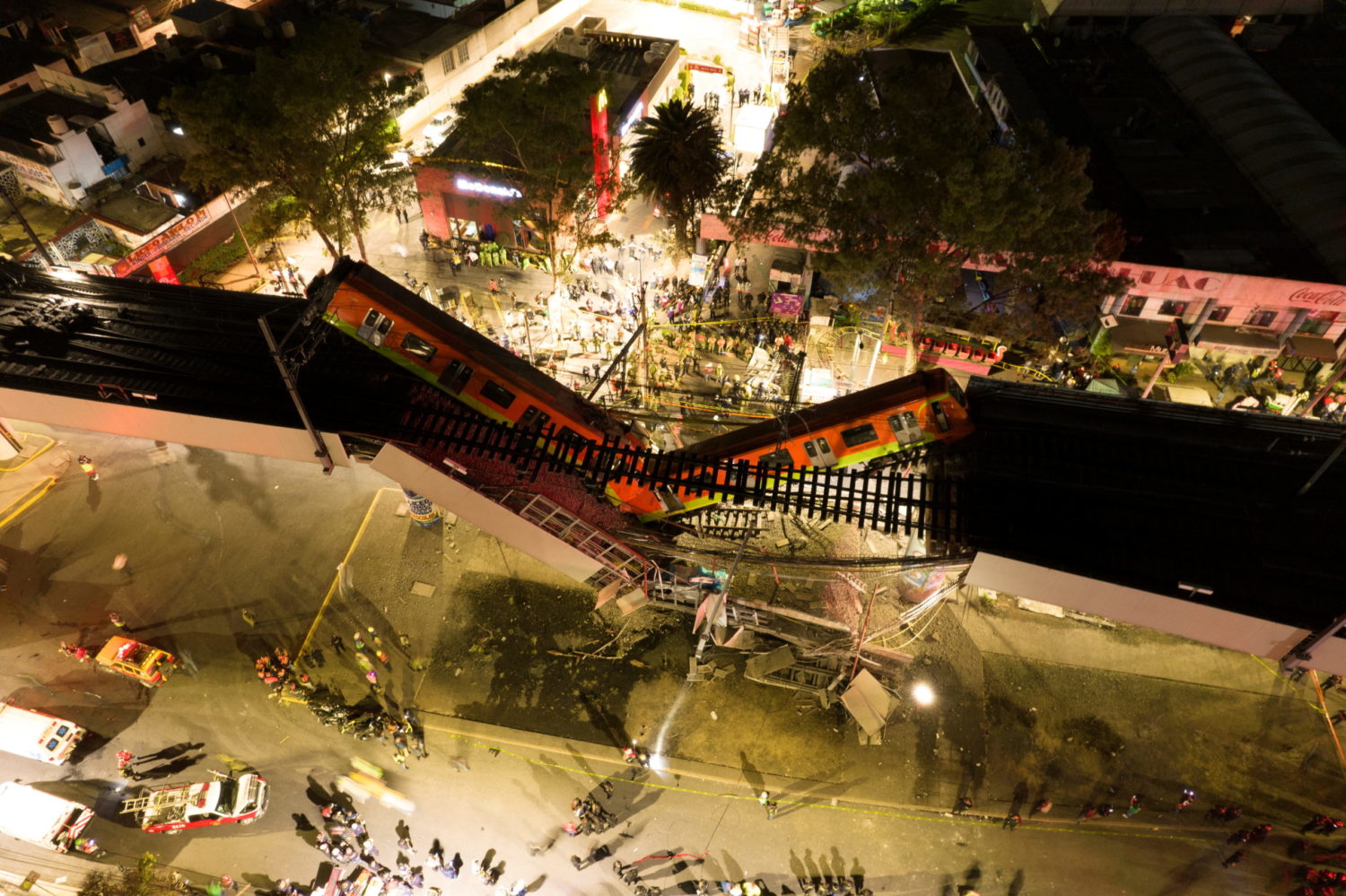
By Daina Beth Solomon and Sharay Angulo
MEXICO CITY (Reuters) -Mexico will find out who was responsible for an overpass collapse that killed at least 24 people and injured dozens more when a train on Mexico City’s newest metro line plunged onto a busy road below, the government said on Tuesday.
Mexican President Andres Manuel Lopez Obrador said the investigation should be done quickly and that nothing should be hidden from the public.
“There’s no impunity for anyone,” he told a news conference.
The crash has raised questions about safety on one of the world’s busiest metro systems, which spreads across an urban sprawl home to over 20 million people. The city has been governed since the turn of the century by former mayor Lopez Obrador and his allies.
Firefighters using heavy chains to stabilize the site pulled bodies and survivors from the wreckage. Some 79 people were injured, including three children, authorities said.
Video on social media showed the moment when the overpass plummeted onto a stream of cars near the Olivos station in the southeast of the city at around 10:30 p.m. (0330 GMT on Tuesday), sending up clouds of dust and sparks.
Monserrat, 26, said she was at the back of the train wagon when she heard a loud noise and the lights went out.
“Everybody screamed and we fell on top of each other,” she told Mexican radio, speaking from the Belisario Dominguez hospital where she was receiving treatment for an injured rib.
Workers on Tuesday hoisted one of two train cars dangling from the bridge using several cranes and slowly lowered it close to the ground. Twisted pieces of metal could be seen inside.
ACCIDENTS
It was the second serious accident this year, after a fire at a central control building knocked out service on several lines for weeks. The overpass that collapsed was part of Linea 12, an addition to the network finished less than a decade ago and long plagued by allegations of corruption.
Four people who live in the area told Reuters they observed the support structures below the elevated tracks visibly shaking when trains crossed. Some recalled warnings about the humid soil being unfit for major construction.
“Every time I saw the train, I saw the columns and beams shake,” said Victor Lara, a daily commuter on the line. “They’re not well made.”
Investigations will be carried out by both the attorney general’s office and an external auditor, the government said.
In 2020, two trains collided on another line of the network, killing one person and injuring dozens.
Lopez Obrador was mayor of the city in the early 2000s, and current mayor Claudia Sheinbaum and Foreign Minister Marcelo Ebrard, who ran the city when Linea 12 was built, are both senior members of his political movement.
In 2014, just two years after it opened, several of the line’s stations were closed for repairs of structural problems.
After a powerful 2017 earthquake, government data show there were also damages to the line’s support columns.
Linea 12 was built by a consortium of CARSO Infraestructura y Construccion, S.A.B. de C.V (CCICSA), a company controlled by the family of Mexican tycoon Carlos Slim, Mexico’s Grupo ICA, and the Mexican unit of France’s Alstom SA.
CCICSA said in a statement to Reuters it stood in solidarity with victims’ families and those injured. “We are going to wait for the official expert opinion,” it said.
Alstom said its involvement in the consortium was limited to certain aspects, including power supply and testing of some electromechanical work. The company said it would aid investigating authorities “in any way necessary.”
ICA did not immediately respond to requests for comment.
Sheinbaum said it appeared a girder had given way on the overpass, which she said was inspected last year.
Ebrard said it was the “most terrible” accident to have hit the local transport system, and that he was ready to cooperate with authorities in the investigation.
At the news conference with Lopez Obrador, Sheinbaum and Ebrard faced questions from reporters about who should be held accountable. Both urged the public to allow investigators to do their work before seeking to apportion responsibility.
The opposition Institutional Revolutionary Party said an investigation and punishment should be carried out “wherever it leads.”
Outside the Belesario Dominguez hospital, family members grew frustrated waiting for information on relatives.
Jorge Hernandez said a woman found his nephew’s phone after he was injured in the accident and called his family. His nephew underwent surgery on his abdomen and was transported via helicopter to another hospital.
Hernandez, a supporter of Lopez Obrador, said he blamed the accident on political corruption, including by those within the president’s inner circle.
“Politicians are used to investing 35% and stealing 65%,” he said. “It’s sad to see how they steal money.”
(Reporting by Daina Beth Solomon and Sharay Angulo, additional reporting by Dave Graham, Raul Cortes and Cassandra Garrison in Mexico City and Gwenaelle Barzic in Paris; Editing by Frank Jack Daniel, Alistair Bell and Jonathan Oatis)












